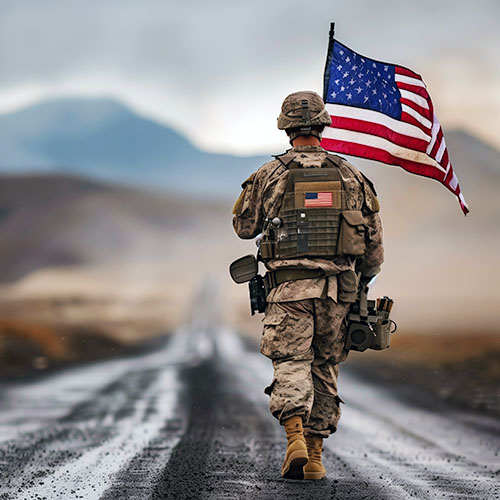The contentious MARSOC 3 case highlights the difficulties faced by accused warriors.
Military Justice: War of the Words
ON New Year’s Eve 2019, Marine Gunnery Sergeants Daniel Draher and Joshua Negron, along with Navy Chief Petty Officer Eric Gilmet, left their covert training facility in Iraqi Kurdistan for a night of fun in Erbil, the region’s capital.
Erbil is a cosmopolitan dot in the desert, one that plies the region’s richest citizens with champagne, steaks and bumping nightlife. Draher, Negron and Gilmet — members of 3rd Marine Raider Battalion, Marine Forces Special Operations Command (MARSOC) — went to dinner, where they talked about their upcoming deployment and training cycles. Then they headed to an expat friend’s haunt, the T-Bar. The mood was celebratory, with streamers and balloons strewn around the tight space. Not long after ringing in the new year, the trio bear-hugged a few buddies and said their goodbyes.
As they neared the exit, Gilmet was confronted by Rick Rodriguez, a tipsy former Green Beret turned Lockheed Martin contractor, who allegedly felt frustrated after being looped out of on-base strategy sessions. Two bouncers noticed Rodriguez’s outburst and quickly shuffled him and his crew of contractors out the door. They kept Gilmet and his buds in the bar for a few minutes, hoping they could discourage any sort of outside altercation.
But Rodriguez stuck around the parking lot. When he saw Rodriguez and his crew, Draher approached him slowly, his arms by his sides. He seemingly wanted to smooth things over, to start the new year on the right foot. Rodriguez did not. He hurled a torrent of swears at Draher, then lunged at him. Draher pushed Rodriguez back, but the beefy contractor returned with two right hooks that dropped Draher to the ground. This spurred a quick, violent scuffle during which Negron knocked Rodriquez unconscious with a single punch.
Rodriguez’s nine companions abandoned him on the street. Gilmet, a Navy Hospital Corpsman, checked his vitals and found him to be stable. The trio lifted him into their truck, drove him to base and watched him overnight. Early the next morning, Rodriguez developed an irregular breathing pattern and was transferred to a medical facility. He ultimately spent four days in the hospital before being declared brain dead and removed from life support.
Draher, Negron and Gilmet were subsequently charged under the Uniform Code of Military Justice with involuntary manslaughter, negligent homicide, obstructing justice, dereliction of duty and violation of orders. The military contended the trio instigated the fight — and believed that Rodriguez suffered a traumatic brain injury from Negron’s blow. The defense pointed to video evidence and first-person accounts to argue that Rodriquez was the belligerent force. They believe he died from complications of intoxication, a claim, they say, is evident from the vomit found in his esophagus during an autopsy.
The tangled case of the so-called MARSOC 3 was championed by United American Patriots (UAP), a well-funded legal network stocked with some of the military’s most fearsome JAGs. Their extensive and sometimes notorious slate of clients and cases reveal many pitfalls in the military court system, which mimic the trappings of civilian courts but remain inherently arbitrary.
In contrast to civilian courts, military defendants can be convicted without the unanimous consent of a jury and have limited avenues for appeal. Many of the accused face no trial at all. Instead, they are processed by administrative boards with loose rules over evidence, testimony and the burden of proof.
Commanders control cases at nearly every turn, bringing charges, convening the court, rationing out each team’s legal resources, supervising prosecutors, and picking a jury. Juries are often unforgiving to the invisible wounds of war, act with prejudice, and protect their own. Fundamentally, the military court system is not designed to ensure justice, but to maintain “good order and discipline.” Sentencing practices are severe and clemency standards narrow.
The MARSOC 3 case perfectly demonstrated these issues. It has become clouded by allegations of racism and undue command influence, with evidence emerging of top brass pressuring subordinates not to assist or testify on behalf of the accused. Some of Gilmet’s charges were dropped after a judge ruled military prosecutors had explicitly threatened the careers of the lawyers defending the trio and pressured certain witnesses against testifying. The judge also found the government submitted false testimony.
UAP’s lawyers pointed to Draher, who is Black, as a symbol of the court’s racist bias and rigged practices, claiming specifically that a senior advisor to the court’s convening authority had a well-documented history of racism toward Marines of color.
Studies have shown shocking racial disparities inside the military justice system. The last man hung by the military was Black Army Pvt. John Bennett, who, in 1955, was charged with raping a girl while deployed in Austria. Bennett, 25, suffered from epilepsy and mental health issues, mitigating factors that were not considered in his swift trial.
The MARSOC case was led by gruff military defense attorney Phillip Stackhouse. His unyielding efforts to point out legal holes and prosecutorial misconduct were largely successful. The most serious charges against Negron and Draher, including homicide, were recently dismissed. (An appeals court will soon consider whether to reinstate some of Gilmet’s charges.) Stackhouse claimed that justice for these defendants was only obtained due to the case’s commanding general securing the proper expert witnesses and resources for the defense team, plus a fair jury. “That does not always happen,” he said. “So, [the judge] ensured a fair process.”
UAP is working to capitalize on public gratitude for service members to push for reforms and forgiveness inside this massive system which, since 9/11 alone, has handed down sentences to more than 1.3 million service members.
And yet some experts worry UAP is giving the reform movement a bad name, taking cover behind soldiers needing protection while pushing military courts to let alleged war criminals off the hook. The nonprofit’s most famous clients include Clint Lorance, Eddie Gallagher and Robert Bales — all figures credibly accused of slaughtering civilians in highly charged cases.
The organization is further accused of conflicts of interests and mismanagement. Critics have charged the nonprofit funnels funds for soldier defense to board members. Gallagher even sued UAP for an alleged “predatory money-making scheme,” claiming officials raised funds off his case but offered little legal assistance. Still, Negron recently made clear to The Military Times that his defense team was an invaluable force. “I’m not sure exactly what the next chapter of my life looks like,” he said. “But I am overall extremely grateful.”
These days, justice itself–even without the capital “J” — can be a seemingly illusory goal. Factor in all the political rancor invading all of our lives, and Military Justice might appear a non-sequitur at best. We must all tread on in belief of the common good prevailing, though, as without hope, what do we have really? … Read more of Jasper Craven’s work at substack.



















